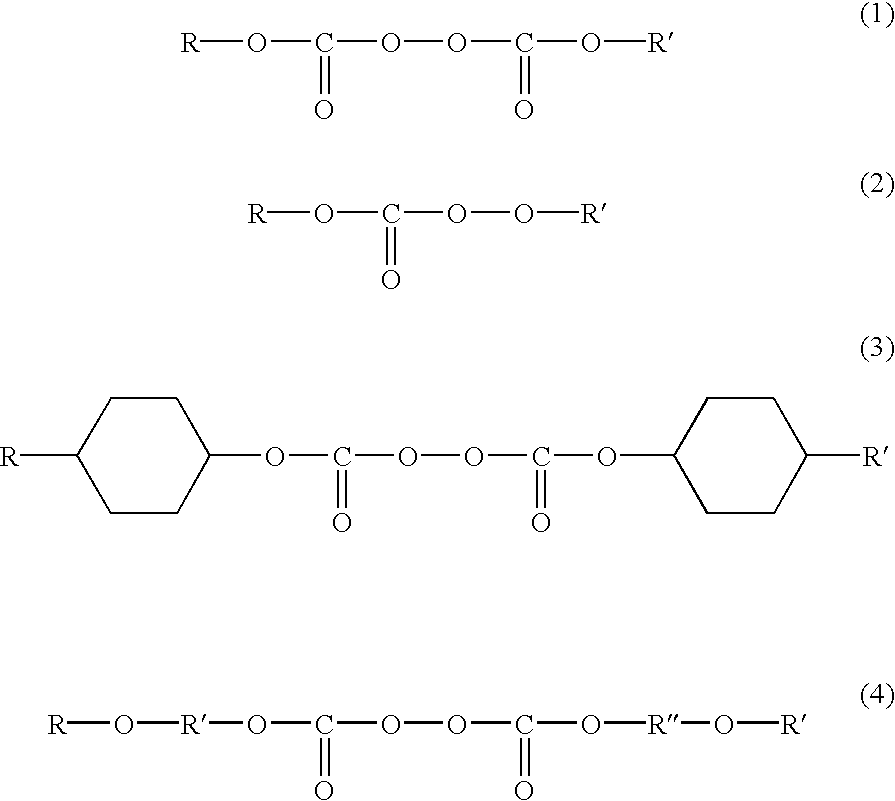Layered resin molding and multilayered molded article
a technology of laminated resin and layered resin, which is applied in the field of laminated resin molding, can solve the problems of low interlayer adhesiveness of polyamide-based resin layers and the layer comprising fluororesin such as fluorine-containing ethylenic polymers, and cannot be applied to coextrusion technology, etc., and achieves the effect of improving the morphology of the adhesive layer according to the molding conditions
- Summary
- Abstract
- Description
- Claims
- Application Information
AI Technical Summary
Benefits of technology
Problems solved by technology
Method used
Image
Examples
synthesis example 1
Synthesis of Polyamide Resin PA-A (Nylon 12)
[0163]An autoclave was charged with 20 kg of ω-laurolactam and 1 kg of distilled water and, after nitrogen purging, the temperature was raised. After arriving at 280° C., the system inside was maintained at this temperature and a pressure of 3.2 MPa for 5 hours and, thereafter, gradually depressurized. During this period, after dissolution in water and melting of ω-laurolactam, the charge was stirred. After restoration of ordinary pressure in the system, 100 g of stearic acid was added and then stirring was further continued at 260° C. for 5 hours in a nitrogen atmosphere, followed by discharging and cooling with water. Treatment on a pelletizer gave white pellets (polyamide resin PA-A). Analyses revealed that these pellets had a melting point of 178° C., an acid value of 28 equivalents / 106 g, an amine value of 6.8 equivalents / 106 g and a relative viscosity of 3.0.
synthesis example 2
Synthesis of Polyamide Resin PA-B (Nylon 11)
[0164]An autoclave was charged with 20 kg of 11-aminoundecanoic acid powder, 5 kg of distilled water and 100 g of a 30% aqueous solution of phosphoric acid and, after nitrogen purging, the temperature was raised in a tightly closed state. The system was maintained at 120° C. for 2 hours and the temperature was then further raised and the system was maintained at 220° C. and 0.4 MPa for 2 hours and, thereafter, gradually depressurized. During this period, after dissolution in water and melting of 11-aminoundecanoic acid, the charge was stirred. After restoration of ordinary pressure in the system, 110 g of stearic acid was added and then stirring was further continued at 265° C. for 4 hours in a nitrogen atmosphere, followed by discharging and cooling with water. Treatment on a pelletizer gave white pellets (polyamide resin PA-B). As a result of analysis, these pellets were found to have a melting point of 186° C., an acid value of 33 equiv...
synthesis example 3
Synthesis of Polyamide-Based Resin Composition PA-C
[0165]The polyamide resin PA-A and N-ethyltoluenesulfonamide were dry blended in a weight ratio of 95 / 5 (sulfonamide group content being 5.2 equivalent percent relative to the amide groups), and the blend was extruded at 260° C. and at a discharge amount of 350 g / minute using a twin-screw extruder (product of Ikegai Tekkosho, PCM-45). After cooling with water, treatment on a pelletizer gave white pellets (polyamide-based resin composition PA-C). The functional group content (%) relative to the amide groups is shown in Table 1.
PUM
| Property | Measurement | Unit |
|---|---|---|
| Temperature | aaaaa | aaaaa |
| Temperature | aaaaa | aaaaa |
| Fraction | aaaaa | aaaaa |
Abstract
Description
Claims
Application Information
 Login to View More
Login to View More - R&D
- Intellectual Property
- Life Sciences
- Materials
- Tech Scout
- Unparalleled Data Quality
- Higher Quality Content
- 60% Fewer Hallucinations
Browse by: Latest US Patents, China's latest patents, Technical Efficacy Thesaurus, Application Domain, Technology Topic, Popular Technical Reports.
© 2025 PatSnap. All rights reserved.Legal|Privacy policy|Modern Slavery Act Transparency Statement|Sitemap|About US| Contact US: help@patsnap.com

